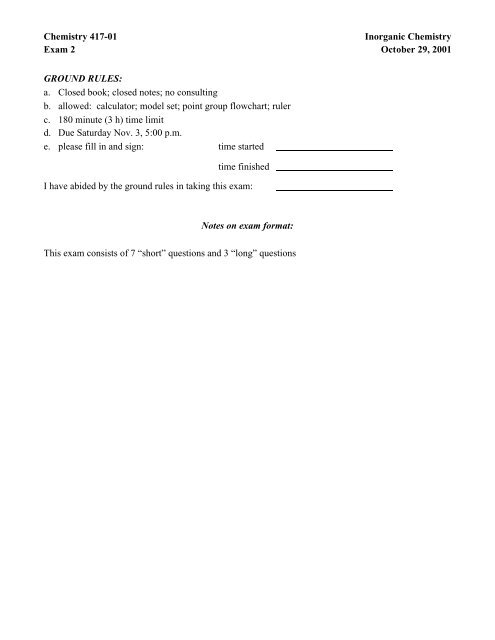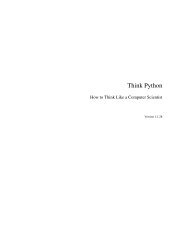Chemistry 417-01 Inorganic Chemistry Exam 2 October 29, 2001 ...
Chemistry 417-01 Inorganic Chemistry Exam 2 October 29, 2001 ...
Chemistry 417-01 Inorganic Chemistry Exam 2 October 29, 2001 ...
Create successful ePaper yourself
Turn your PDF publications into a flip-book with our unique Google optimized e-Paper software.
<strong>Chemistry</strong> <strong>417</strong>-<strong>01</strong><strong>Inorganic</strong> <strong>Chemistry</strong><strong>Exam</strong> 2 <strong>October</strong> <strong>29</strong>, 20<strong>01</strong>GROUND RULES:a. Closed book; closed notes; no consultingb. allowed: calculator; model set; point group flowchart; rulerc. 180 minute (3 h) time limitd. Due Saturday Nov. 3, 5:00 p.m.e. please fill in and sign: time startedtime finishedI have abided by the ground rules in taking this exam:Notes on exam format:This exam consists of 7 “short” questions and 3 “long” questions
Short Answer Sectiona. The enthalpies of reaction of trimethylboron with NH 3, CH 3NH 2, (CH 3) 2NH and (CH 3) 3N are -58, -74,-81, and -74 kJ/mol respectively. Briefly explain the likely reason why trimethylamine is out of line.b. (i) HBr and HI are equivalently strong acids in water due to solvent leveling. Explain.(ii) What is a solvent in which the relative strengths of HBr and HI could be determined? (Show,using a chemical equation.)c. In terms of hard-soft acid-base theory, which end of the SCN - anion would coordinate to:(a) Cr 3+ (b) Pt 2+Briefly explain your choices.2
d. Which of each pair is the stronger acid in water? For each case, briefly explain why?(i) SnH 4(ii)HClO(iii) [Ru(H 2O) 6] 2+For part (iii), give a chemical equation that shows how the ion you chose acts as an acid.e. Show equations for how the following compounds react when placed in water. (Hint: each onemakes a solution with pH>7.)(i) NaH(ii) NH 3f. Using the principles of HSAB theory, determine whether K eq> 1 or K eq< 1 for the followingreaction. Briefly explain.Cl 3Al—PEt 3+ Cl 3In—NMe 3Cl 3Al—NMe 3+ Cl 3In—PEt 33
g. Using Drago-Wayland E, C parameters, determine which of Et 3N, Et 2O and PMe 3is the strongerbase toward GaMe 3.4
Longer questions1. Consider the following series of six platinum compounds.number molecular formula # of ions1 PtCl 2·4NH 332 PtCl 2·3NH 323 PtCl 2·2NH 304 PtCl 2·2NH 305 KPtCl 3·NH 326 K 2PtCl 43From the molecular formulas and numbers of ions produced when each compound is dissolved inwater, deduce the structural formula of each compound, being explicit as to which ligands are in thecoordination sphere. Draw structures for each platinum containing molecule or ion. Note thatcompounds 3 and 4 are isomers (one is polar, one is non-polar). All of the compounds have thesame geometry at platinum—what is that geometry?5
2. (a) Draw a molecular orbital diagram for H 2.(b) Label the orbitals with the proper symmetry label (σ or π) and label any non-bonding and antibondingorbitals.(c) What is the point group of H 2?(d) Sketch the atomic and molecular orbitals as part of your diagram.(e) Using the MO diagram for H 2, interact two H 2fragments to make tetrahedral H 4. You shouldconsider tetrahedral H 4to be formed by the approach of 2 H 2fragments perpendicular to oneanother as shown in the drawings below. Arrange your coordinate system as you like.approach at 90° angletetrahedral H 4HHH(f) Label the MO’s of H 4 in order of increasing energy φ 1, φ 2, φ 3, φ 4.(g) Sketch the shape of these four MO's.(h) How many nodes does each orbital have?(i) Are any of the orbitals degenerate in energy? If so, which ones?(j) What is the point group of tetrahedral H 4?HHHHH6
3. Give a clear well-labeled molecular orbital diagram for the HCl molecule. Pay attentionto the relative energies of the orbitals used to make the diagram. Valence orbital energy levels aregiven at the end of the exam. Include pictures of all orbitals (atomic and molecular).7
Useful information:Selected E and C parameters for the Drago E,C equation:-∆H° (kJ/mol) = E A E B + C A C BacidE A(kJ/mol) 1/2C Abase E B(kJ/mol) 1/2 (kJ/mol) 1/2C B(kJ/mol) 1/2BMe 3 11.84 3.21 py 2.66 13.68AlMe 3 35.43 1.92 NH 3 3.03 6.79AlEt 3 28.39 2.88 Me 3 N 2.43 22.91GaMe 3 28.<strong>29</strong> 0.82 Et 3 N 2.64 22.15GaEt 3 25.63 0.39 Me 2 O 2.21 5.97InMe 3 26.98 0.76 Et 2 O 2.21 6.30SbCl 5 16.12 10.41 THF 2.17 8.43BF 3 24.93 1.66 Me 2 S 1.17 14.67Et 2 S 1.13 15.14Me 3 P 2.27 13.32Me 2 Se 1.00 16.388
Valence orbital potential energies:Orbital potential energy (eV)Atomic Element 1s 2s 2p 3s 3pNumber1 H -13.62 He -24.53 Li -5.54 Be -9.35 B -14.0 -8.36 C -19.5 -10.77 N -25.5 -13.18 O -32.4 -15.99 F -46.4 -21.610 Ne -48.5 -21.611 Na -5.212 Mg -7.713 Al -11.3 -6.<strong>01</strong>4 Si -15.0 -7.815 P -18.7 -10.<strong>01</strong>6 S -20.7 -12.<strong>01</strong>7 Cl -25.3 -13.718 Ar -<strong>29</strong>.3 -15.99
linear?NoYesGroup of low symmetry?(lacking any C n ?)σh?NoYesNoYesGroup of high symmetry?(≥2 C nw/ n>2 for each)D ∞hC ∞vC 1 , C i , C sNoYesHighest orderrotation axis (n)?Td, Oh, IhC nAre there n ⊥ C 2 ’s?YesNoD n groupsC n or S 2n groupsσ h ?σ h ?D nhYesNoYes Noσ d ?C nh σ v ?Yes NoYesD nd DC nvnNoS 2n ?YesNoS 2nC n10
















